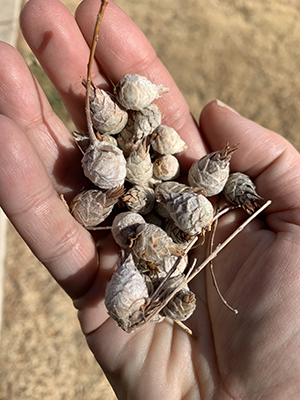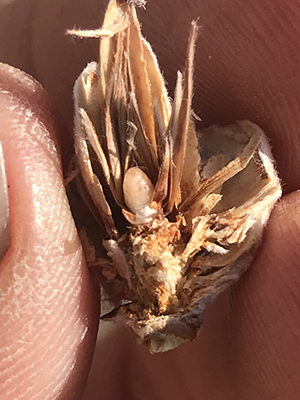December 7, 2019
Willow Cone Gall Midges: More Charm than Harm
Question:
What are these beautiful, tiny cones on willow branches near Abiquiu?
- Malcolm S., Visiting New Mexico for Thanksgiving Holiday
Answer:
At first glance, I thought either these aren’t cones or these aren’t willow trees because willows don’t have cones like this, or buds like this either. Full disclosure, the question this week came from my cousin, Malcolm, and I was standing right there next to him. I had noticed the small, multi-trunked trees and assumed they were our native coyote willows (Salix exigua). But I hadn’t noticed that many of these small trees lining the dry streambed were covered in miniature cone structures.
Had these “cones” been dangling and covered in leaf debris—like a shaggy grey-brown ornament—I would have thought they’re a form of bagworm. The structures bagworms make look like leafy sleeping bags hanging from branches that sway in the breeze, but the ones on these willow trees were attached firmly, weren’t hanging at all, and were harder and more solid-feeling than the bagworms I’ve collected. (For more info on bagworms, check out NMSU Plant Diagnostic Clinic publications.
I guessed that they might be caused by some kind of gall insect, so Malcolm and I peeled the tight leaf layers off of one and, sure enough, right there hunkered down in the middle was a tiny white larva, about the size of a grain of rice.
I collected about 20 of them and stuffed them in my coat pocket. Once we got home, I checked my handy reference book “Insects and Diseases of Woody Plants in Colorado,” published by Colorado State University Extension. I love this book for several reasons, one of which is that it has a section in the back called “Diagnostic Key to Some of the More Common Woody Plant Disorders.” This section is organized by plant species, so I searched under “Willow (Salix spp.).” Within each species section the key is further divided into which part of the plant is affected (e.g., affecting leaves or affecting trunk). Under “Affecting twigs,” one of the descriptions was “Cone-like gall at end of twig... Willow conegall midges, page 146.” Bingo.

These cone gall midges (Order Diptera, Family Cecidomyiidae), also spelled conegall, are flies that, in larval form, bite on the twig tips of various native willows—not humans. And these tiny bites, made in the early spring, cause the entire twig to stop elongating, but leaves continue to form. The growth is so compact, without internodes between the leaves, that they form these tight cone-like or pineapple-like tips. Yes, you read that correctly. As the reference book states on page 146, “The larvae feed on the terminal growth of willow and prevent the stems from normally elongating… Feeding by the larvae causes the bud to cease further development, remaining bud-like but still capable of directing plant nutrients to the tissues. The bud swells as the small fly larva develops within a cavity in the bud. The larva spends the winter in the gall and pupates in the early spring.” How cool is that?!
I searched the NMSU Plant Diagnostic Clinic database for willow gall samples that might have been submitted in recent years. I didn’t find this willow cone gall midge, but I did find many samples that have been diagnosed as being gall-related. Gall-making midge larvae in swollen piñon needles and gnarled oak leaf midges from oak trees in Bernalillo County were reported this year. I’ve seen galls on fourwing saltbush, netleaf hackberry trees, and ash tree branches too. When searching for evidence of galls on your landscape plants, look for wart-like bumps on leaves as well as pineapple tips on willows. If you find some, share them with your County Extension Agent. But don’t worry too much. As Dr. Carol Sutherland, NMSU Extension Entomology Specialist and NMDA Entomologist, advised in the reports for those piñon and oak samples submitted to the NMSU Plant Diagnostic Clinic, there’s no need to try to control them. These gall-makers are not harming their host.

Marisa Y. Thompson, PhD, is the Extension Horticulture Specialist, in the Department of Extension Plant Sciences at the New Mexico State University Los Lunas Agricultural Science Center, email: desertblooms@nmsu.edu, office: 505-865-7340, ext. 113.
Links:
For more gardening information, visit the NMSU Extension Horticulture page at Desert Blooms and the NMSU Horticulture Publications page.
Send gardening questions to Southwest Yard and Garden - Attn: Dr. Marisa Thompson at desertblooms@nmsu.edu, or at the Desert Blooms Facebook page.
Please copy your County Extension Agent and indicate your county of residence when you submit your question!